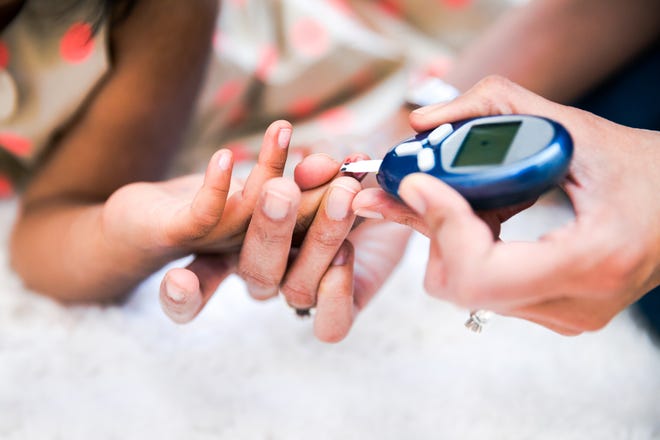The American Diabetes Association on Monday unveiled new standards of care that reflect changes in technology, improved medications, and a better understanding of the disease and social factors that contribute to the management of diabetes.
The standards are updated annually, but this year includes approximately 100 new or revised recommendations affecting all types of diabetes.
Guidelines are provided to doctors online as well as on the app. Last year, he was accessed more than 4 million times worldwide, said Dr. Robert Gabbay, Chief Scientific and Medical Officer of the Diabetes Association.
“The focus of our guidelines is to reduce the burden of disease for people with diabetes,” said Dr. Nuha El-Sayed, chair of the association’s Professional Practices Committee, which created the revision. It’s central to what we do.”
In addition to changing standards for weight control, blood pressure and cholesterol control, the revisions also aim to address racial disparities in care, El-Sayed said.
Racial differences in diabetes have no biological basis, and the guidelines are designed to “help people see the big disparities in care and outcomes.”

weight management
Gabbay said that new tools, especially more effective weight-loss drugs, will come to market to give diabetics more control over their weight.
Losing 15% of your body weight, as opposed to the previously recommended 5%, should provide more health benefits, he said.
“Today, we have better tools to achieve these goals and it’s becoming a reality,” Gabbay said.
The guidelines remain the same regarding diet and exercise, including eating a balanced diet and reducing processed foods and added sugars. he said.
Prevention of cardiovascular and kidney disease
Diabetes is the leading cause of heart disease, and heart disease is the leading cause of death for people with diabetes, Gabbay said.
In line with the American College of Cardiology, new guidelines include a low goal of blood pressure above 80 and below 130. For the bad kind of LDL cholesterol, new guidelines call for a measurement of 70 in people without heart disease (up from 100) and 55 instead of 70 in those with established heart disease.
Gabey says statins are very good at lowering cholesterol levels, and other drugs can effectively lower blood pressure to meet these goals.
“There are many studies showing that lower goals yield better results for people with diabetes.
The guidelines also call for more aggressive treatment to prevent progression of chronic kidney disease. “Diabetes continues to be the leading cause of end-stage renal disease,” Gabbay said.
“There is a social need and, fortunately, scientific evidence to support appropriate treatments for these conditions,” he said.
Cut prevention
Black Americans with diabetes are three to four times more likely to have limb amputations than whites with the same condition, and amputation rates are getting worse, not better, according to Gavey.
New guidelines call for more careful screening for foot ulcers and peripheral arterial disease, both of which can lead to amputation.

sleep is important
Both quality and timing of sleep are important, said Gavey. “Not too much, not too little,” he said. “When it comes to diabetes, both are associated with poor outcomes.”
According to new guidelines, doctors should counsel diabetics about good sleep habits and identify those who have trouble sleeping.
Many people with diabetes are prone to sleep apnea, a dangerous condition in which breathing temporarily stops during sleep. Treating diabetes, especially weight loss, can improve sleep apnea, and improving sleep apnea may help control diabetes, he said.
Addressing social factors
All people with diabetes should be screened for problems that may interfere with proper diabetes management. For example, food insecurity, food deserts with few options, or living in a “food swamp” where only processed foods are available. Said.
“Educating people about healthy eating when they can’t have access to healthy food will only lead to frustration,” Gabey said.
“I want the whole diabetes medical team to get involved in asking people about more than just food,” El-Sayed added. “Did they lose their jobs? Do they live in a safe area before telling them to exercise?”
According to Gabbay, the value of community health workers has been demonstrated to help them stick to medications and lifestyle changes, especially for underserved and disadvantaged populations.

Improving access to technology
Gabbay said doctors don’t recommend high-tech treatments like automated insulin delivery devices or glucose pumps because they tend to think that older people aren’t comfortable with technology.
Instead, new guidelines recommend providing everyone, including older patients, with the latest technology.
Blacks and other people of color often have less access to advanced technology than whites, so the Diabetes Association created a technology access program to promote racial equity.
“Everyone should have access to technology that can help them beat diabetes,” said Gavey.
When people are given technologies like continuous blood glucose meters, they often describe them as “innovative” and “game-changers,” Gavey said. Or we need to provide continuous glucose monitoring for people of all ages, including insulin dependent children, adults and the elderly.”
Are the changes enough?
While the change in guidelines is important and necessary, Leon Rock, co-founder of the African American Diabetes Association, says it’s too late to adequately address diabetes in blacks.
Historically, the American Diabetes Association has been guilty of “tragic neglect” of black people with diabetes, he said. problems and do not provide sufficient financial support to historically black university diabetes researchers.
“As money moves in and out of the ADA, it continues to flow to institutions such as Yale, Harvard, Boston University, and Boston College, rather than historically black schools. He said he hasn’t done enough to deal with
“It’s a start,” Rock said.
Please contact Karen Weintraub at kweintraub@usatoday.com.
Health and patient safety coverage on USA TODAY is made possible in part by a grant from the Masimo Foundation for Ethics, Innovation and Competition in Healthcare.Masimo Foundation does not provide editorial information
